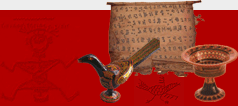| 您的位置:首页 --> 与会学者 --> 论文提要 |
试论凉山彝族无形文化遗产及其保护
On Safeguarding Intangible Cultural Heritage of Nuosu People in
Liangshan Area
阿牛史日 Aniu Shiri
四川凉山美姑县档案局
【摘要】彝族无形文化遗产,不仅是彝族精神文化的宝库,而且是彝族新文化赖以生存发展的根与脉。不断传承和保护这种“草根文化”,就是对文化多样性的肯定,就是保护人类自身。本文就凉山彝族无形文化及其传承、保护做一个探讨,以期引起有识之士的重视,同时推进各级党政机关保护意识的形成。
关键词:彝族 无形文化遗产 多样性 保护
Abstract
The intangible cultural heritage of the Yi is not only a treasure
house of Yi spiritual culture, but is also the root and framework
that the existence and development of new Yi culture will have
to rely upon. To continually inherit and protect this kind of
“grass-roots culture” is to ensure cultural diversity and to preserve
humanity. This paper discusses the intangible culture of the Yi
of Liangshan and its transmission and preservation, in order to
induce the respect that emerges from purposeful knowledge, as
well as stimulate the formation of a preservation consciousness
at all levels of party and government.
Keywords: Nuosu─intangible cultural heritage─diversity─safeguarding
作者简介:
阿牛史日,男,彝族,1964年10月出生于四川美姑县,研究生学历,现为中国民俗学会会员、四川省民俗学会会员,先后毕业于西南民族学院彝语文专业、四川师范大学汉语言文学专业,主要从事彝族文献及彝族无形文化的研究与保护工作,主要著作有《大凉山美姑民间艺术研究》(合著),主要论文有《彝族毕摩文献及其价值探述》、《关于彝族文字与文献的几个问题》、《从彝族挽歌“阿古伙”看彝族的灵魂意识及死亡观》、《神奇幻化的彝族巫医术》、《抓好两件事,推进档案工作新跨越》、《中学语文课堂结构艺术》等。
About the author:
Aniu Shiri (Anyu Shyssyr) was born in Meigu in October 1964,
and is a member of the China Folklore Association and the Sichuan
Folklore Association. He has degrees in Yi language and literature
from Southwest Nationalities University and in Han language and
literature from Sichuan Normal University. His primary work is
in the area of Yi historical documents and the preservation of
Yi intangible cultural heritage. He is the joint author of Research
on the Arts of Meigu, Da Liangshan, and his major articles include
“Yi Bimo documents and their Worth,” “On Some Questions Regarding
Yi Writing and Documents,” “Looking at Yi ideas about death and
spirits from the antiphonal song ‘Agurhxo’,” “Yi shamanistic healing
arts,” “With a firm hold on two things, promote advances in archival
work,” and “The art of structure in middle-school classrooms.”
|





